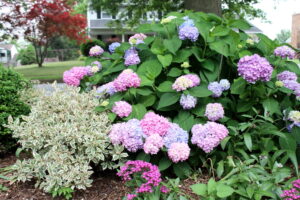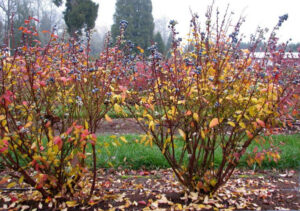Why One Bloom Time Is No Longer Enough
July 30th, 2024
American gardeners love their azaleas, lilacs, and hydrangeas for the spectacular spring floral shows these classic shrubs put out.

Endless Summer hydrangea is one of the best known of the new reblooming shrubs.
But after a year in the making, the show is over in two or three weeks. Wouldn’t it be nice if these plants could bloom longer… or better yet, bloom again in the same season?
That’s been happening more and more lately as plant breeders and plant-development companies have been delivering a host of reblooming versions of our favorite shrubs and perennial flowers.
The two biggest deja-vu breakthroughs so far are in reblooming hydrangeas and reblooming azaleas.
Minnesota’s Bailey Nurseries hit paydirt when it developed the Endless Summer hydrangea, a variety that produced softball-sized flowers of blue or pink (depending on soil acidity) in late summer and fall in addition to the main June bloom.
Aided by its distinctive blue pot and heavy marketing, Endless Summer has become one of America’s top-selling plants. The brand now extends into six reblooming varieties, including the lacecap-flowered Twist-n-Shout, a deep-rosy bloomer called Summer Crush, and the new compact Pop Star.
Numerous other reblooming hydrangeas have followed suit, including the Let’s Dance, Forever and Ever, Seaside Serenade, Magical, and Everlasting series.
Louisiana plantsman Buddy Lee cracked the azalea code with an introduction he called the Encore azalea that rebloomed in fall after a first performance in May.
The Encore line has since grown to nearly three dozen different azalea varieties, including 24 that are winter-hardy to the Harrisburg area’s USDA Zone 6b/7a climate rating.
It’s also led to reblooming azaleas from other growers, including the Bloom-a-Thon, ReBLOOM and Double Shot series.
The success of those two cases opened the floodgates for breeders to find rebloomers in just about every other shrub genus.
Recent years have brought us two colors of reblooming weigelas (Sonic Bloom), seven versions of reblooming lilacs (the Bloomerang series), and 10 varieties of reblooming spireas (the Double Play series) – all sold under the Proven Winners brand.
Plants Nouveau two years ago introduced the first reblooming ninebark, a variety called Sweet Cherry Tea that’s dwarf in size and that also sports dark foliage.

This is what Perpetua blueberries look like in fall.
Credit: BrazelBerries
And the USDA’s Agricultural Research Service even is into the act by developing a blueberry – Perpetua – that not only flowers a second time but produces a second crop of blueberries in the fall.
Getting woody plants to rebloom is no quick or guaranteed enterprise.
One difficulty is getting that second bloom to amount to much. In fact, most of the rebloomers on the market so far rebloom less spectacularly than the debut show – or they’ll rebloom only sporadically.
A second difficulty is developing varieties that are genetically stable enough to hold the reblooming trait in the long term – and do so in varying climate zones and varying year-to-year weather.
The best road to rebloom is starting with plants or species that sometimes naturally flower in the fall.
Many gardeners have seen this in their own yard when a fall warm spell follows a cold period.
A forsythia or rhododendron or weigela, for example, will strangely send out a smattering or so of flowers in November, prompting worried calls to Extension offices about whether something is going woefully wrong in the landscape.
In fact, the usual explanation is that the spring- or early-summer-blooming plant has been tricked by the weather into “thinking” it’s already gone through winter.
Most woody plants that bloom in March, April, May, and June bloom on what’s known in the plant industry as “old wood.”
Old wood is growth that occurred the year before. Flower buds form on this old wood in summer and fall, then normally stay dormant over winter until opening the following year.
Different species have different chill-time requirements before they’ll open.
In our increasingly wacky up-and-down autumns, species with short chill times are particularly prone to partial fall flowering.
While that’s not harmful to the plant, it does lessen the spring show a bit since some of the buds did their thing the fall before.
Plants prone to premature blooming are particularly useful for breeders looking to capitalize on varieties they can market as rebloomers.

Encore azaleas, blooming in the fall.
Credit: Encore Azaleas
Lee, for example, crossed an azalea with a strong predilection for summer and fall blooming (‘Fourth of July’) with other late-bloom leaners to come up with his Encore azalea line.
A second possibility is finding/developing plants that produce flower buds on both old and new wood.
Summer-blooming shrubs such as panicle hydrangeas, butterfly bushes, rose of sharon, and caryopteris bloom later in the season because they first grow that season’s new wood, then set buds on that wood that open soon after. (This explains, by the way, why your “regular” azaleas won’t bloom if a deer eats them in winter while butterfly bushes will.)
A reblooming jackpot occurs when a woody plant manages to muster two decent flower sets in the same year – an early one on last year’s old wood and a later one on that year’s new wood.
That’s the magic behind Endless Summer’s rebloom and many other woody rebloomers.
A third avenue is finding or developing plants with sterile seeds.
Plants flower not to please us but primarily to lure pollinators that will transfer pollen from the male part of one flower to the female part of another, leading to seeds and fruits that will make sure the plant continues on to the next generation.
If plants aren’t producing mature seed, a sort of reboot function goes into action in which the plant tries again with new flowers – i.e. a rebloom.
By finding, developing, and reproducing varieties that have sterile flowers, breeders can use this try-again trait to meet gardeners’ lust for ever-longer, ever-better yard color.
Sterile plants also have the side benefit of no unwanted seeding, which is useful for ensuring that a new introduction doesn’t turn into an invasive plant.
Not all so-called rebloomers do two distinct sets of flowering – one in spring and one in fall with a rest period between.
Some are more accurately “continuous” bloomers that just keep chugging along until they finally give up.
That’s the case with many shrub roses as well several of the so-called new “reblooming” shrubs and the many reblooming perennials.
Although a few reblooming perennials, such as reblooming irises and reblooming daylilies, really do repeat-bloom, most of the above are just exceptionally long-blooming varieties. And most of those are encouraged when the gardener deadheads spent flowers or shears off the whole first round of browned-out flowers.
That prevents seeds from maturing, which diverts the plant’s energy and attention to trying again.
Some of the best cutback reblooming perennials are salvia, catmint, yarrow, coreopsis, hardy geranium, agastache, tall garden phlox, and dianthus.
With most any bloom over-achiever, a little extra fertilizer usually helps.
It burns a lot of energy keeping gardeners happy all season long.







